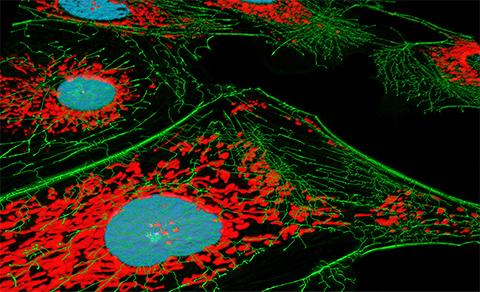From the Journals: JBC
Nuclear actin affects transcription elongation. Proteostasis in Alzheimer’s disease. RNA and splicing affect cancer invasiveness. Read about papers on these topics recently published in the Journal of Biological Chemistry.
Nuclear actin affects transcription elongation
Monomeric actin assembles to form long filaments that regulate cell mobility and division, but actin monomers are also important in some nuclear processes, including chromatin remodeling and gene expression. For example, actin is involved in the pause–release of Polymerase II, or Pol II, in which the positive transcription elongation factor b, or P-TEFb, interacts with Pol II to promote transcription elongation. Actin also frequently co-immunoprecipitates with Pol II. However, scientists have not yet characterized the direct binding partners that mediate actin–RNA polymerase interactions.

To catalog actin-binding proteins within the nucleus, Salla Kyheröinen and colleagues at the University of Helsinki, Finland, used chromatin immunoprecipitation followed by deep sequencing in a recent study. Their results, published in the Journal of Biological Chemistry, indicated that actin associates with genes only upon active transcription elongation. They also found that monomeric actin does not directly bind Pol II but rather binds the P-TEFb subunit Cdk9, which also co-immunoprecipitates with RNA polymerases. They demonstrated that this binding is independent of Cdk9’s kinase activity, although at high concentrations actin does modestly affect this kinase activity.
These findings provide novel insights into the mechanisms by which actin can facilitate transcription. However, while these results suggest actin binding is important for pause–release and transcription elongation, researchers have yet to determine the mechanism by which the actin–Cdk9 interaction affects this process. In addition, scientists still don’t know whether this interaction involves recruiting the P-TEFb complex to Pol II or influences the kinase activity of Cdk9. Researchers will need to perform detailed biochemical analyses in the future to elucidate the precise steps at which actin affects transcription elongation rate.
Proteostasis in Alzheimer’s disease
Alzheimer’s disease, or AD, is a neurodegenerative disorder characterized by dysregulation of the amyloid-beta protein and the amyloid precursor protein, or APP. AD patients frequently present with deposits, or plaques, of aggregated amyloid β, indicating protein quality control issues such as aberrant synthesis, misfolding and inefficient degradation. Most AD research focuses on the expression of APP and posttranslational cleavage of APP to form amyloid β; however, investigating ribosome-associated quality control before APP cleavage could provide researchers with new avenues for understanding AD pathogenesis.
In their recent article in the Journal of Biological Chemistry, Yu Li and colleagues at Shandong University in China used fruit flies expressing mutant APP that accumulates in the endoplasmic reticulum to identify novel factors and molecular mechanisms that regulate APP quality control. In their genetic screen, they found that deletion of RACK1, encoding a protein that associates with the ribosome for translational control, and overexpression of IRE1, a key sensor of the unfolded protein response, reduced levels of mutant APP. Furthermore, they also showed that IRE1-dependent changes depended on the ATPase VCP, a protein that helps degrade polypeptides at stalled ribosomes, and Hrd1, an E3 ubiquitin ligase. Researchers already knew that both VCP and Hrd1 regulate the expression and toxicity of non-mutant APP. Therefore, these results emphasize their role in APP quality control and homeostasis.
This study demonstrated a link between the ribosome-associated quality control pathway and APP proteostasis. Future studies could identify novel therapeutic targets among these molecules to reduce APP-associated neurodegeneration.
RNA and splicing affect cancer invasiveness
Tandem repeats in pericentromeric regions, such as those that make up human satellite II, or HSATII, can be aberrantly transcribed in cancers, such as epithelial and pancreatic cancer. Furthermore, genetic dysregulation in these cancer tissues often promotes double-stranded HSATII RNA, or dsHSATII. However, research has shown that double-stranded RNAs can both promote and suppress tumors. In addition, researchers do not yet know how dsHSATII affects tumor progression.
In their recent study in the Journal of Biological Chemistry, Takuma Iwata and colleagues at the University of Tokyo investigated the function of dsHSATII in pancreatic cancer. They found that dsHSATII RNA promotes mesenchymal-like morphological changes and enhances the invasiveness of pancreatic cancer cells. In addition, they identified an RNA-binding protein, spermatid perinuclear RNA-binding protein, or STRBP, that preferentially binds to dsHSATII over single-stranded HSATII. STRBP is also involved in the alternative splicing of genes associated with the epithelial–mesenchymal transition, or EMT. Using 3D cell cultures and xenograft models, the authors demonstrated that STRBP suppresses dsHSATII’s role in EMT by altering the expression of CLSTN1, an EMT-associated gene that encodes for a transmembrane protein with activity as a cell adhesion molecule. An isoform of CLSTN1 is associated with metastasis and poor prognosis for certain types of cancer.
These results reveal that the novel dsHSATII–STRBP signaling axis regulates EMT in pancreatic cancer. Researchers will need to do more studies in the future to investigate the mechanistic details of this signaling axis and whether STRBP regulates additional genes or could be a novel therapeutic target.
Enjoy reading ASBMB Today?
Become a member to receive the print edition four times a year and the digital edition monthly.
Learn moreGet the latest from ASBMB Today
Enter your email address, and we’ll send you a weekly email with recent articles, interviews and more.
Latest in Science
Science highlights or most popular articles

Bacteriophage protein could make queso fresco safer
Researchers characterized the structure and function of PlyP100, a bacteriophage protein that shows promise as a food-safe antimicrobial for preventing Listeria monocytogenes growth in fresh cheeses.

Building the blueprint to block HIV
Wesley Sundquist will present his work on the HIV capsid and revolutionary drug, Lenacapavir, at the ASBMB Annual Meeting, March 7–10, in Maryland.

Gut microbes hijack cancer pathway in high-fat diets
Researchers at the Feinstein Institutes for Medical Research found that a high-fat diet increases ammonia-producing bacteria in the gut microbiome of mice, which in turn disrupts TGF-β signaling and promotes colorectal cancer.

Mapping fentanyl’s cellular footprint
Using a new imaging method, researchers at State University of New York at Buffalo traced fentanyl’s effects inside brain immune cells, revealing how the drug alters lipid droplets, pointing to new paths for addiction diagnostics.

Designing life’s building blocks with AI
Tanja Kortemme, a professor at the University of California, San Francisco, will discuss her research using computational biology to engineer proteins at the 2026 ASBMB Annual Meeting.

Cholesterol as a novel biomarker for Fragile X syndrome
Researchers in Quebec identified lower levels of a brain cholesterol metabolite, 24-hydroxycholesterol, in patients with fragile X syndrome, a finding that could provide a simple blood-based biomarker for understanding and managing the condition.

